The French artist who is credited with inventing one of the most fascinating art movements of the 19th century produced an incredible number of paintings.
Claude Monet (1840-1926) is credited with painting 2,500 artworks during his nearly 7-decade long career and stuck to the ideals of the Impressionist art movement this entire time.
He put a high emphasis on depicting nature as he perceived it, en Plein air (outdoors). Today, his paintings have sold for millions of dollars and are on display in the most popular museums all around the world.
Let’s take a closer look at some of the most famous Claude Monet paintings, artworks of the famous Impressionist artist that have a special place in his immense oeuvre.
1. Impression, Sunrise
- Date created: 1872
- Dimensions: 48 × 63 cm (18.9 × 24.8 inches)
- Location: Musée Marmottan Monet, Paris, France
Impression, Sunrise is the painting that is credited with being the inspiration for the name of the Impressionist movement of the late 19th century. It depicts the port of Le Havre, the hometown of Monet in the Normandy region of France.
It was a revolutionary painting in the sense that it went against what was expected of landscape paintings from a conventional point of view. It’s hazy and doesn’t feature idealized beauty. It was exhibited at the first exhibition of the Impressionists in Paris in April 1874.
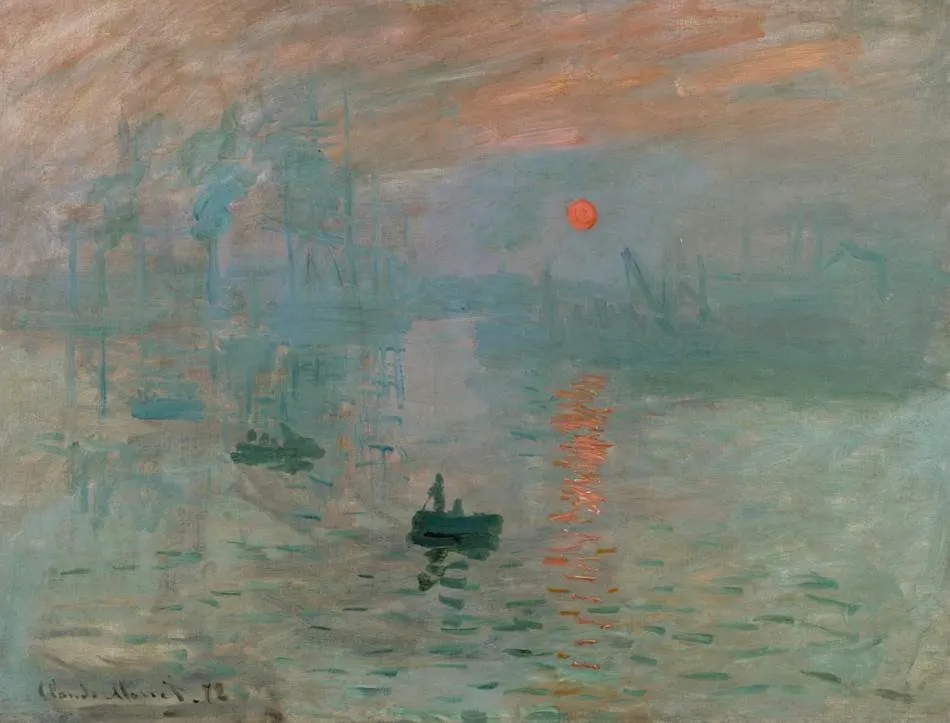
2. Le Déjeuner sur l’Herbe
- Date created: 1865-1866
- Dimensions: 248.9 × 218 centimeters (98 × 85.8 inches)
- Location: Musée d’Orsay, Paris, France
Le Déjeuner sur l’Herbe is also known as “Luncheon on the Grass” and was a response painting to the heavily criticized work of Édouard Manet which he painted in 1863. Manet formed the bridge between the Realism artists and Impressionist artists at this time in history.
Monet’s painting remained unfinished and depicts well-dressed Parisians in the woods while they are having a picnic. The seated man is Gustave Courbet (1819-1877), one of the most renowned Realism artists of the 19th century.

3. Water Lilies
- Date created: 1919
- Dimensions: 101 × 200 centimeters (40 × 79 inches)
- Location: Metropolitan Museum of Art, New York City, United States
Water Lilies is one of the approximately 250 paintings in the oeuvre of Claude Monet that depict water lilies in the pond of his garden. He worked on developing this garden at his home in Giverny during the final decades of his life.

This particular painting was produced in 1919 and consists of two panels. We can see the light reflecting off the water and the water lilies that grow on the pond’s surface. He also painted his garden and the Japanese bridge over his pond multiple times.

4. Wild Poppies, near Argenteuil
- Date created: 1873
- Dimensions: 65 x 50 centimeters (25.59 x 19.68 inches)
- Location: Musée d’Orsay, Paris, France
Wild Poppies, near Argenteuil, is a painting that Monet produced while he was living in Argenteuil, a town that is now part of the northwestern suburbs of Paris. He lived here between 1871 and 1878 before moving to the village of Vétheuil and later Giverny.
This was a period shortly after he got married to his wife Camille and after returning from exile in London. During his stay in the UK, he learned a lot from the paintings of J.M.W. Turner, the most renowned Romantic artist of his time. This painting depicts his wife Camille as she is walking through a poppy field in Argenteuil.
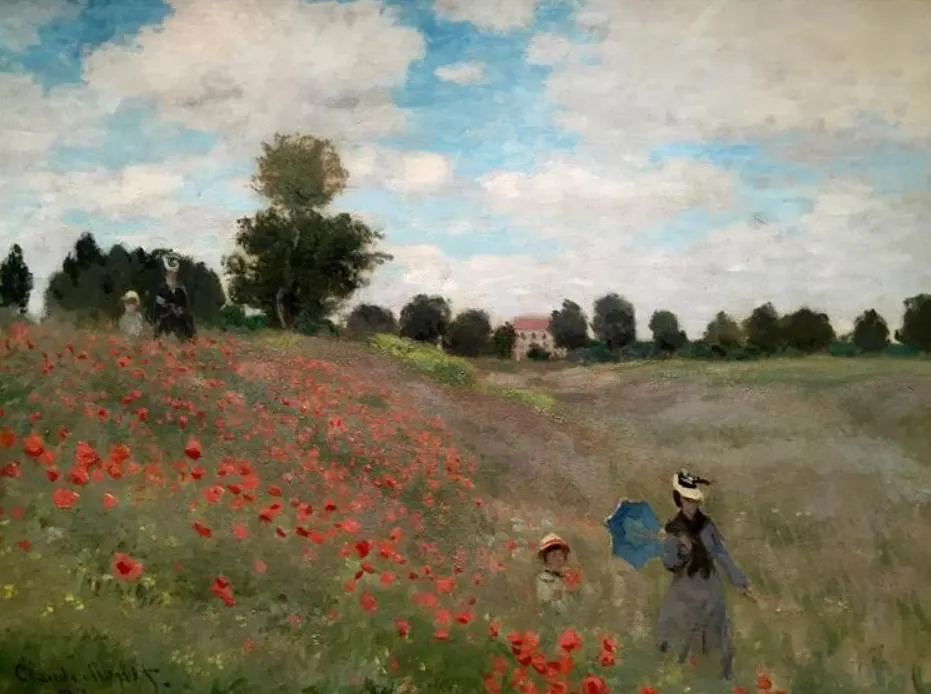
5. Woman with a Parasol
- Date created: 1875
- Dimensions: 100 × 81 centimeters (39 × 32 inches)
- Location: National Gallery of Art, Washington, DC, United States
Woman with a Parasol is a painting with a similar subject as Wild Poppies, near Argenteuil, but provides us with a closer view of the artist’s wife. We can see again the presence of the couple’s son, Jean Monet, who is wearing the same hat as well.
The painting was produced on a windy day, something that allowed the artist’s wild brushstrokes to shine. This painting made its way to the United States and was part of the second exhibition of Impressionists in April 1876.
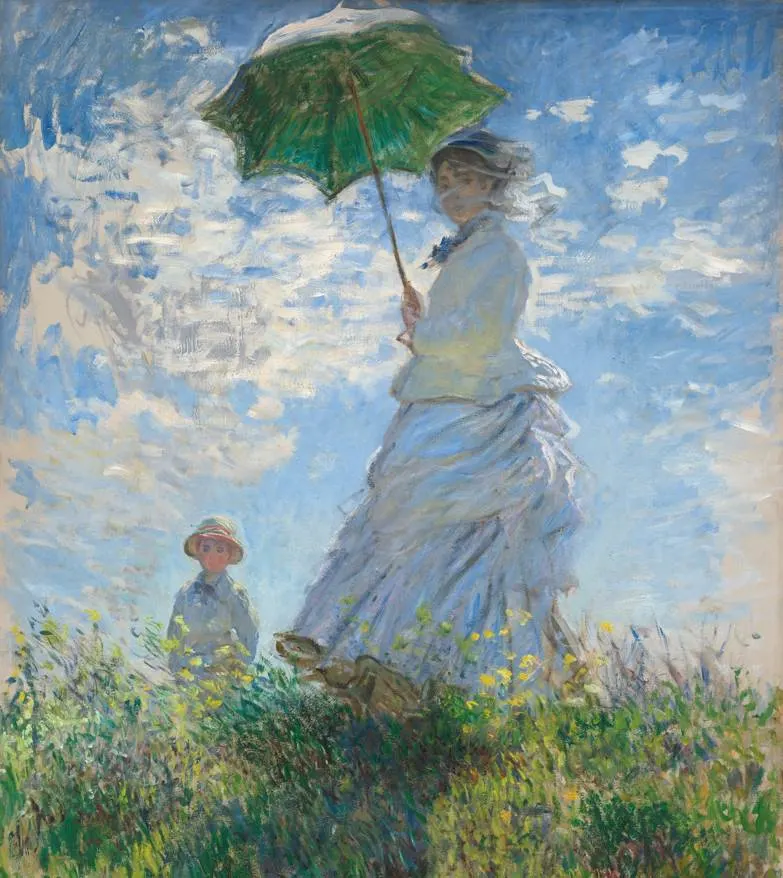
6. The Artist’s Garden at Giverny
- Date created: 1900
- Dimensions: 81.6 × 92.6 centimeters (32.1 × 36.5 inches)
- Location: Musée d’Orsay, Paris, France
The Artist’s Garden at Giverny depicts the garden that he worked on for the final decades of his life after moving to the small town of Giverny in 1883. It’s here that he produced many of his famous while working on landscaping his garden.
This lifelong project wasn’t in vain, and not just because it resulted in some of the most famous Claude Monet paintings in history. His house was renovated and restored to its former glory and has served as a popular tourist attraction ever since. This painting depicts rows of irises in different shades of purple and pink.
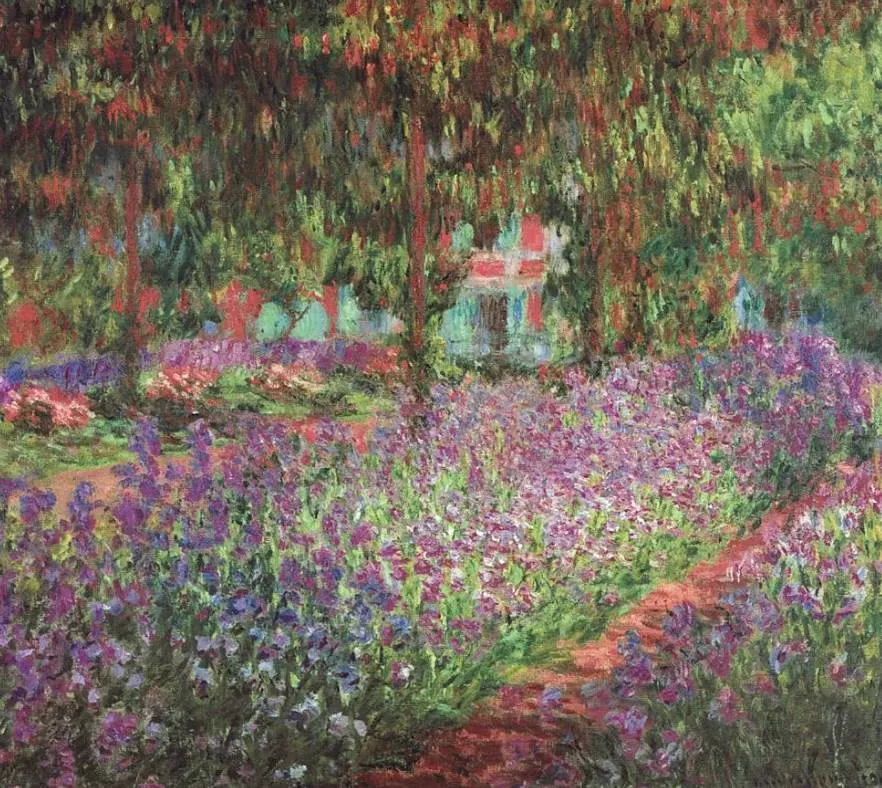
7. San Giorgio Maggiore at Dusk
- Date created: 1908-1912
- Dimensions: 65.2 × 92.4 centimeters (25.7 × 36.4 inches)
- Location: National Museum Cardiff, Wales
San Giorgio Maggiore at Dusk is a painting that depicts the small island named as such that is part of Venice, Italy. It was painted shortly after the final trip that he made in his life, a voyage to Venice together with his second wife Alice in 1908.
This painting at the National Museum of Cardiff is one of the multiple variations of the same subject. It depicts the structures that make up the San Giorgio Monastery and church on the small island early in the morning in the typical hazy Impressionist style.

8. The Magpie
- Date created: 1868-1869
- Dimensions: 89 × 130 centimeters (35 × 51 inches)
- Location: Musée d’Orsay, Paris, France
The Magpie is a winter landscape that was produced during the early phase of the artist’s career, before he even painted Impression, Sunrise. It was painted during the winter months in the small town of Étretat in Normandy, about 32 kilometers (20 miles) from his home city of Le Havre.
He painted approximately 140 snow landscapes during his life and was named after the small magpie that sits on top of a gate. It’s one of the first paintings in which the artist made use of his so-called “colored shadows,” a distinct feature of Impressionist artists. The shadow created by the sunlight was painted in a dark shade of blue, producing this remarkable effect.

9. The Houses of Parliament, Sunset
- Date created: 1903
- Dimensions: 81.3 x 92.5 cm (32 x 36.43 inches)
- Location: National Gallery of Art, Washington DC, United States
The Houses of Parliament, Sunset, is remarkably similar to the painting of San Giorgio Maggiore in Venice, especially the color scheme used by the artist. It depicts the Palace of Westminster in London in the early hours of the day.
The painting at the National Gallery in Washington DC is also part of a series of Claude Monet paintings of the same subject. The color schemes differ based on the time of the day that he painted them. The viewpoint is the same in all works as he painted them from his room at St Thomas’ Hospital on the opposite side of the River Thames.
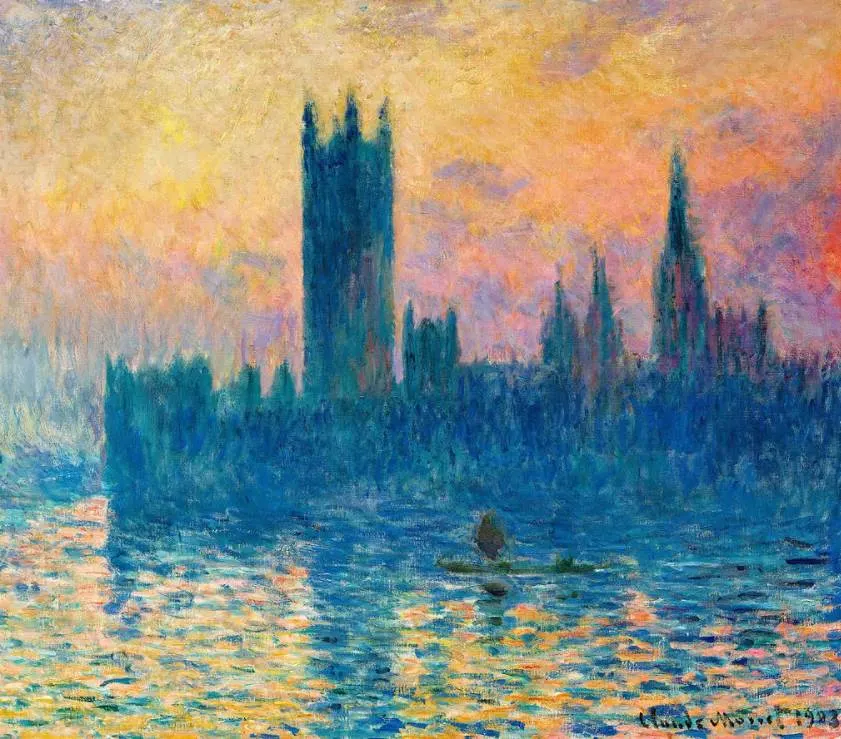
10. Bain à la Grenouillère
- Date created: 1869
- Dimensions: 74.6 × 99.7 centimeters (29.4 x 39.3 inches)
- Location: Metropolitan Museum of Art, New York City, United States
Bain à la Grenouillère is a painting that depicts a scene in Croissy-sur-Seine, a commune in what is today the western outskirts of Paris. It depicts a floating restaurant known as La Grenouillère from which boats could be hired.
We can also see people swimming in the Seine, a subject that he focused on in an accompanying painting called “Bathers at la Grenouillére” which is on display at the National Gallery in London. Monet was accompanied by his colleague Pierre-Auguste Renoir (1841-1919) who painted this scene at the same time.

